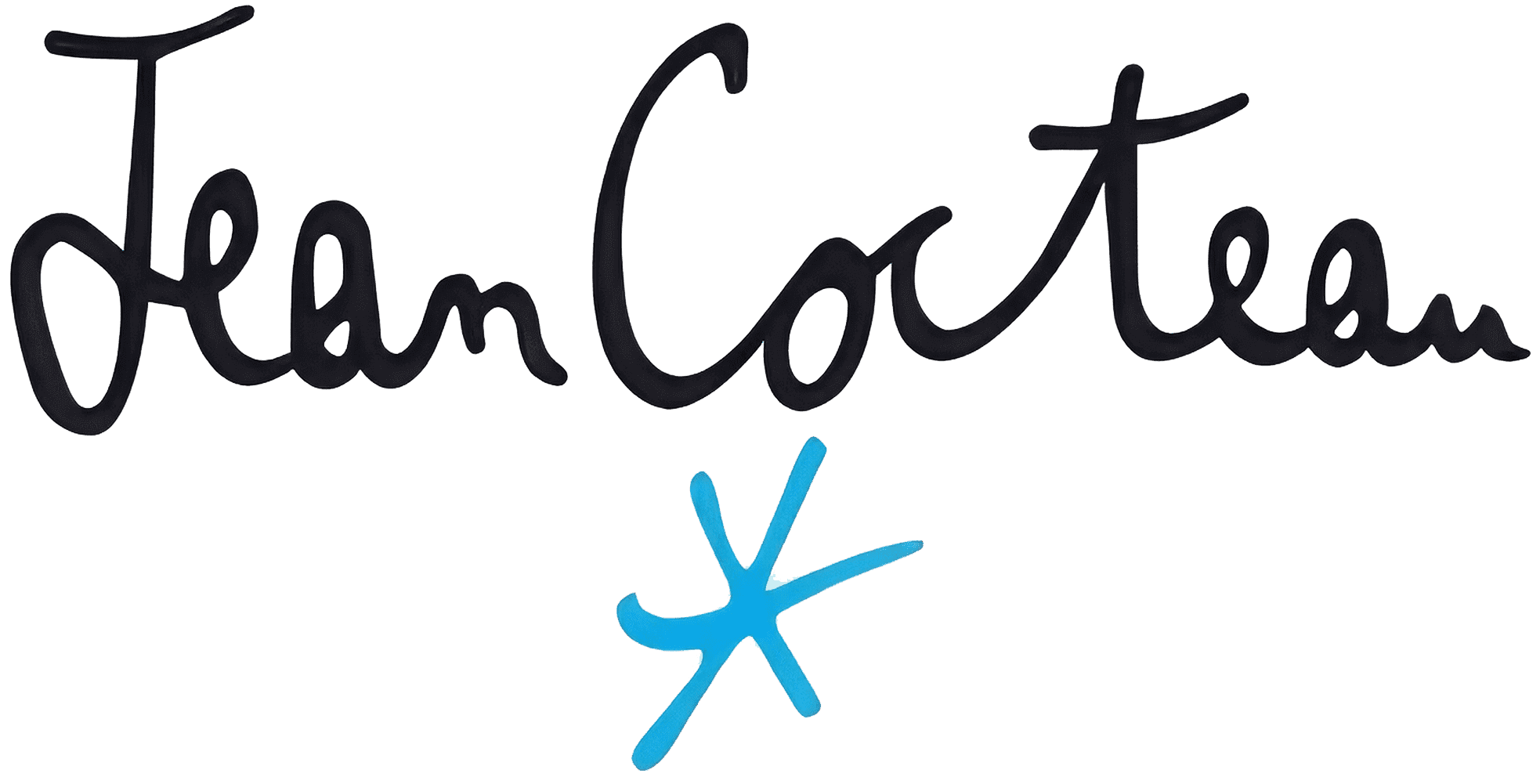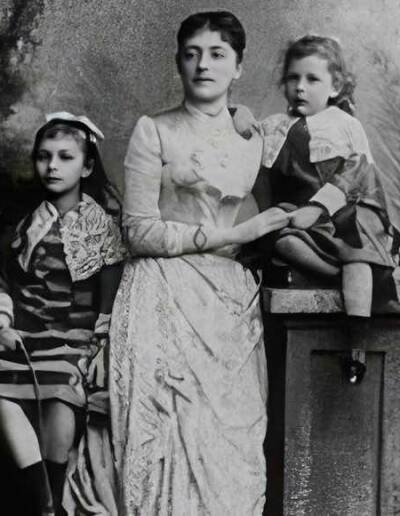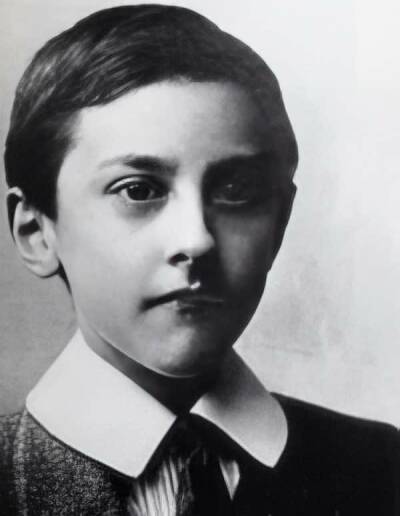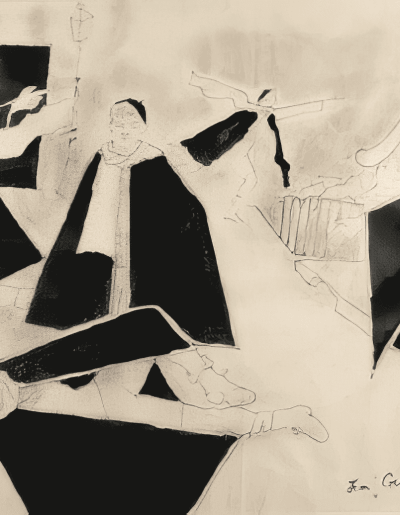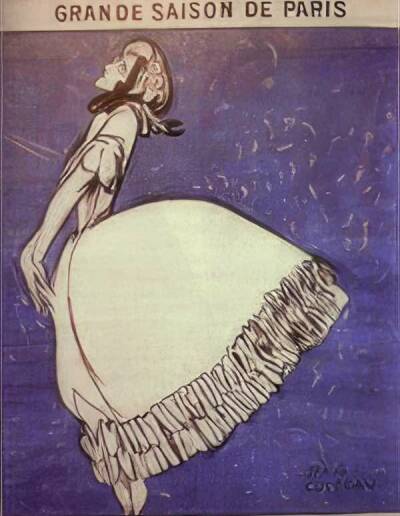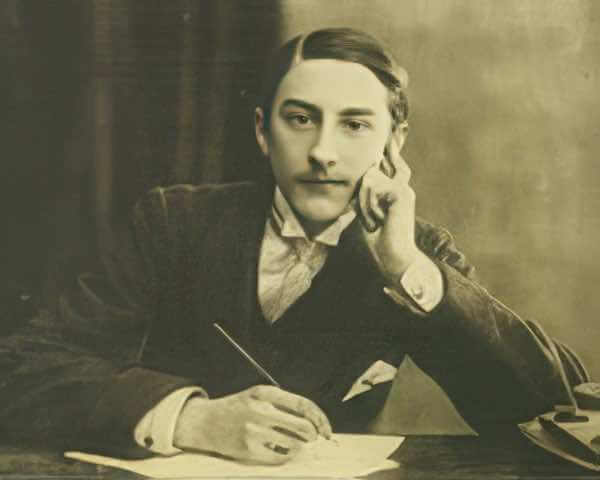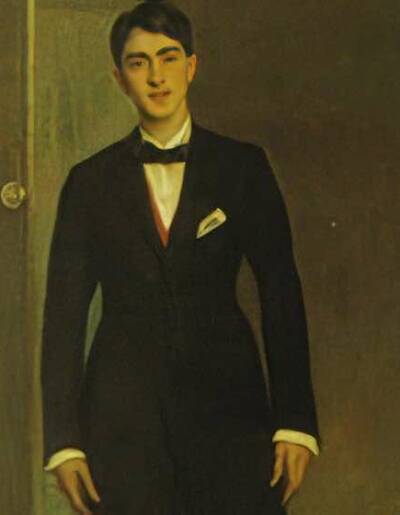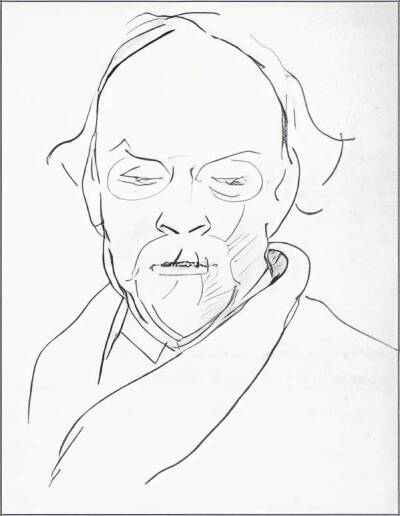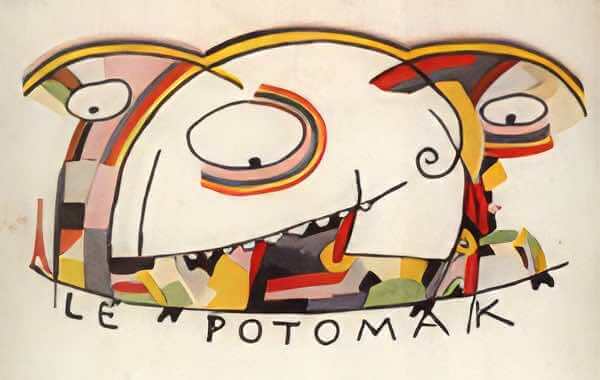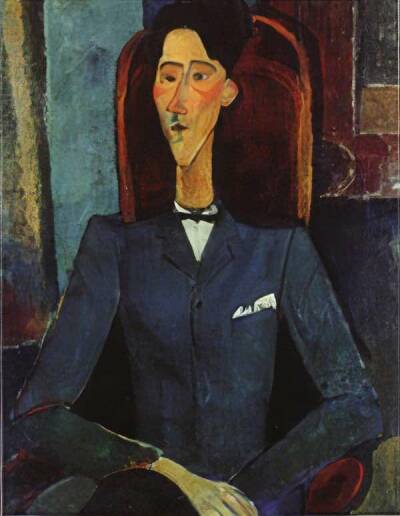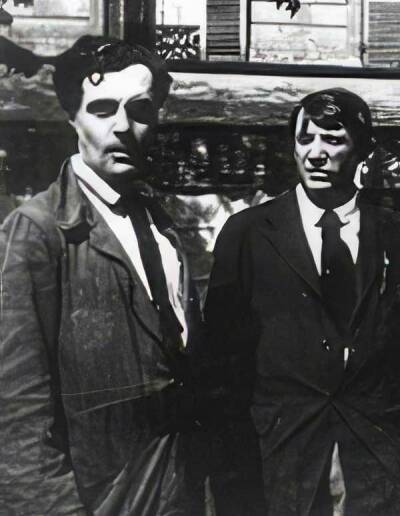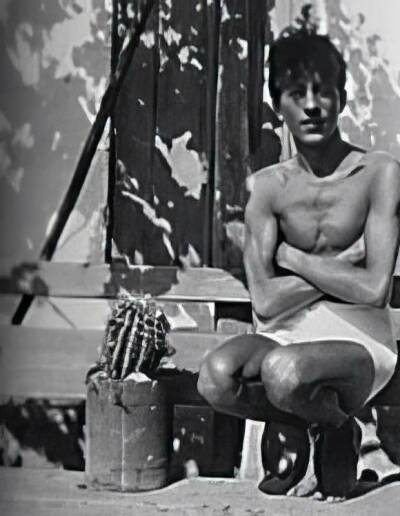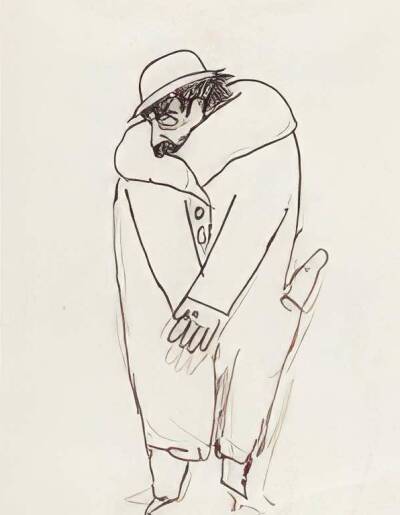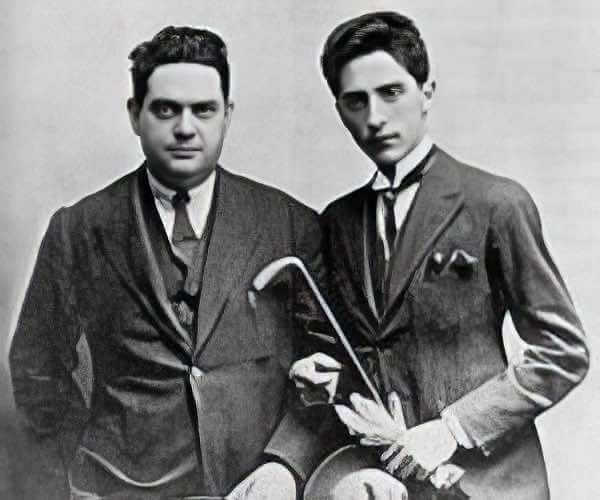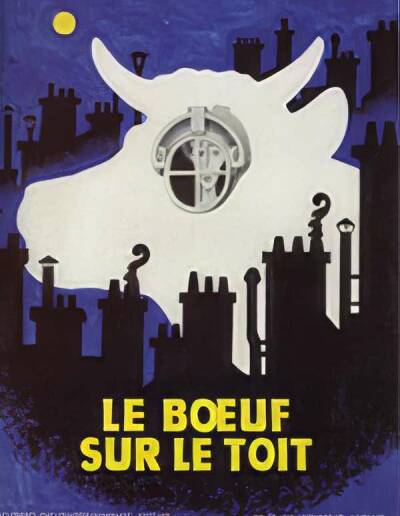Jean Cocteau, the son of Georges and Eugénie, is born on July 5th in Maisons-Laffitte. The couple already have two children: Marthe, born in 1877 and Paul, born in 1881.
The family lives with their maternal grandparents in a town house at 45 rue La Bruyère in Paris during the winter and at a property in Maisons-Laffitte during the summer. Jean is a pampered but nervous child. He has a capricious character and is often ill. He grows up in a mondain milieu where the arts are held in high esteem. His father draws and, at an early age, Jean starts to do the same. His grandfather is a collector and a music lover who organises musical sessions in the house. Fascinated by the theatre, Jean devours the specialist magazines he finds at home; he also attends several stage performances for children.
On April 5th, for reasons that remain a mystery, his father puts a gun to his head and commits suicide. It takes until 1963, the year of his own death, for Cocteau to speak publicly of the tragedy on the TV documentary Portrait-souvenir.
In the spring, grandmother Lecomte dies. The grandfather continues to live with his daughter. He looks after Jean and takes him to concerts at the Conservatory every Sunday.
At the Universal Exhibition, Cocteau is awestruck by the dance performance given by Loïe Fuller. In August, he holidays in Switzerland. In October, after a period of primary schooling that by all accounts was below average and often interrupted by ill-health, he begins his first year in high school at the Petit Condorcet. His fellow students include Dargelos whom he will transform into a legendary character.
He plays with his school friends in the cité Monthiers at 55 rue de Clichy (a location he will use in Blood of a Poet, Opium et Les enfants terribles (Children of the Game)). The death of an unidentified friend has a major impact on him. It is also a year in which he experiences the sudden revelation of beauty in a pupil and feels the "desire to be join those he finds beautiful rather than worry about being liked by them."" It is a sentiment he will later attribute to Jacques, the hero of the Grand Ecart (The Great Divide).
In October, he begins his third year of high school at the Grand Condorcet. He excels in just three subjects –drawing, gymnastics and German. His teachers find him intelligent but inconsistent, inattentive and restless.
Jean travels to Châtel-Guyon and Venice with his mother.
Jean is expelled from school at Easter due to his chronic absence. He completes the academic year by taking private lessons and in October he begins his fourth year of high school at the école Fénelon in rue du Général-Foy. He draws profusely.
Jean is still enrolled at the école Fénelon. He spends the summer at the home of his friend Rocher in La Boissière, near Moy, in the Aisne.
In April, grandfather Lecomte dies. With his friends Rocher and Boulant, the young Cocteau becomes an habitué of the café-cabaret Eldorado where Dranem and Mistinguett perform. During May and June, he has a brief affair with Jeanne Reynette, one of the cabaret’s artists. In July, he fails his baccalaureate. We have no account other than his own regarding an incident in which he absconded to Marseille and his brother was dispatched to find him. To prepare him for his second attempt at the baccalaureate, his mother sends him to Val André and the home of Herman Dietz, a teacher at the lycée Buffon who takes boarders during the summer break. In October, Jean fails his baccalaureate again. He takes additional private lessons under the stewardship of Dietz in the rue Claude-Bernard.
Mme. Cocteau leaves the house in Rue La Bruyère and moves to a smaller home at 62 Rue Malakoff (now called Avenue Raymond-Poincaré) where she is able to maintain the lifestyle to which she is accustomed. Henceforth she lives alone with Jean. Jean, meanwhile, again fails to pass his baccalaureate despite another extended visit to the Dietz’s in Val-André during August and September. He will not continue his studies. Instead, he writes poems, develops a passion for theatre and, no doubt due to the influence of De Max, persuades himself that a great future awaits him.
His mother introduces him into society and he quickly earns a reputation as a dandy. He mixes with Catulle Mendès and makes friends with Lucien Daudet and Maurice Rostand. On April 4th, at the Théâtre Fémina on the Champs-Elysées, De Max organises a morning of poetry devoted to "a young 18-year-old poet, Jean Cocteau" with a presentation by Laurent Tailhade. The event is a great success in academic and literary circles. On May 12th, Cocteau attends the opening of the Salon des poètes and on July 15th publishes his first poem "Les Façades" in the review Je sais tout. In September, he travels to Italy with his mother: to Isola Madre on Lake Maggiore, then to Verona and Venice. On the 24th, while in Venice, his friend Raymond Laurent kills himself shortly after leaving Cocteau’s company. Once again, Cocteau’s youth is marked by death. Unbeknown to his mother, on his return to Paris he moves into a pied-à-terre in the gardens of the Hôtel Biron in Rue de Varenne. He has a brief affair with Christiane Mancini, a student at the Conservatory.
Cocteau’s literary activity is intense. In January, he works on plans for the magazine Schéhérazade with Maurice Rostand. Six issues will be published between November 1909 and March 1911. He also publishes articles and drawings in Comoedia. In February, his first anthology of poems, La Lampe d’Aladin (Aladdin’s Lamp) is published. Following the Paris premiere of the Ballets Russes on May 19th, Misia Sert introduces him to Serge de Diaghilev. That summer, he is invited to the home of the Rostands in Arnaga in the Basque country. On November 20th, in Le Témoin he draws a caricature of the actress Madeleine Carlier with whom he has an affair and whom he introduces as his fiancée.
Mme. Cocteau moves to 10 Rue d’Anjou, where she will live until the outbreak of war in 1939. Jean spends less and less time under his mother’s roof. Even so, she continues to watch over him, intervening directly to end his relationship with Madeleine Carlier and to make him give up his lodgings in the Hôtel Biron. He is introduced into Madeleine Lemaire’s salon by Lucien Daudet and Reynaldo Hahn. He meets Proust at the home of Mme. Straus, the widow of Bizet. He meets Jacques-Emile Blanche and François Mauriac. At the end of May, his second anthology of verse, Le Prince frivole (The Frivolous Prince) is published. In August, he travels to Clarens with André Paysan, a contributor at Schéhérazade. Together, they write La Patience de Pénélope, de Pénélope, mensonge en un acte (The Patience of Penelope, a lie in one act), with music by Reynaldo Hahn. More of Cocteau’s articles and drawings are published in Comoedia.
On February 14th, he meets the Comtesse de Noailles, whom he greatly admires. Whilst at the home of Mme. Simone in Trie la Ville, he also meets Alain Fournier and Péguy. At the same time, Diaghilev introduces him to Stravinsky. He spends Easter in Cap Martin with his mother, Mme Daudet and Lucien Daudet. The latter introduces him to the Empress Eugénie. He spends August with the Daudets at château de La Roche near Amboise. Throughout the year, he publishes articles and drawings in Comoedia, Comoedia illustré and Les Humoristes ; he writes the libretto for a ballet, Le Dieu bleu (Blue God) ; and he designs two playbills for Le Spectre de la rose He also writes "Ballet Russe", a text for the troupe’s programme.
In February, he poses at the home of Jacques-Emile Blanche, who paints his portrait. From March 12th to April 8th, he travels to Algeria with Lucien Daudet. On May 13th, Dieu bleu (Blue God), is performed by the Ballets Russes to music by Reynaldo Hahn. Karsavina and Nijinsky are among the dancers. However, the work is poorly received by the public – something that will greatly impact Cocteau. At the same time, Diaghilev issues Cocteau with his famous challenge: "Etonne-moi!" ("Astound me!""). At the end of June his third book of verse, La Danse de Sophocle (The Dance of Sophocles), is published. The judgement of the critics, together with the failure of his ballet and Diaghilev’s comments, lead him to question the value and meaning of his early successes. A busy summer itinerary helps to distract him: he spends from August 8th to August 15th at the home of Jacques-Emile Blanche in Offranville where he meets Princesse Bibesco. The second half of August is spent at the château de La Roche with the Daudets, then in Saint-Jean-de-Luz with his mother and finally, in Cambo at the Rostands where he remains until the end of September. At the end of the year, the death of Henri Bouvelet, a contributor to Schéhérazade again leads him to anguish over the tragic destiny of certain young people. Some of his poems and prose appear in Comoedia, Le Figaro, La Revue de Paris, Je sais tout and Les Annales.
In April and May, Cocteau stays at the Trianon-Palace Hotel in Versailles with Maurice Rostand. On May 29th, the premiere of Rite of Spring, enraptures him; the hostility shown by the public confirms his notion that artistic creativity can but be non-conformist. He works on a project with André Lhote to direct A Midsummer Night’s Dream. From August 11th to September 16th and from October 7th to November 7th, he stays with Jacques-Emile Blanche in Offranville: he poses for another portrait and tries his hand at painting, surprising and disconcerting his host. On October 14th, he meets Gide for the first time. He begins work on what is to become Le Potomak and sketches his first Eugènes. On November 23rd, his article on Swann’s Way, written at the instigation of Proust, is published in Excelsior. The same month, a mutual friend introduces him to Roland Garros. He takes his first flight in the company of the aviator, though the exact date of the flight remains uncertain.
In January he visits Stravinsky, who is passing through Paris. He presents him with a project for a ballet – a music hall "parade" entitled David. However, reminded by Diaghilev of his previous commitments, Stravinsky will never complete the ballet. Back in Paris, Cocteau finishes Le Potomak. Though ruled unfit for military service, he does not wish to remain inactive when war is declared. At the beginning of August, he joins the Red Cross and is responsible for numerous humanitarian tasks. In September, he joins a convoy to evacuate the wounded from Champagne and witnesses the bombardment of Reims. Back in Paris, he visits Barrès: the discussions disappoint him. He prepares the journal Le Mot with Paul Iribe. The first issue appears on November 28th. He signs his drawings under the pseudonym of Jim. On the 26th, the military review board for the Department of the Seine designates him for auxiliary service. He volunteers for the Army’s Ambulance Section, created by Etienne de Beaumont and leaves for the front in Flanders.
In January, Le Mot becomes a weekly; its twentieth and last issue will be published in July. Cocteau meets Raoul de Castelnau who inspires him to create the character of Thomas the Imposter. On February 14th Le Figaro publishes his Hymne à Joffre on the front page. Cocteau begins writing the poem that will become Le Cap de Bonne-Espérance (Cape of Good Hope). Valentine Gross introduces him to the world of modern painting. He is called up for active duty on March 4th and is transferred on the 18th as backup to the 22nd section of clerical workers. On November 13th he is given a deferment to the Société française de secours aux blesses – an organisation to aid wounded servicemen – in rue François Ier. Whilst there, he is assigned to the ambulance service. On December 18th, he is sent as an ambulance man to a unit of marines at the front in Nieuport. The end of the year will prove decisive to his artistic direction. He meets Erik Satie at the home of Valentine Gross and launches the project for Parade. At the beginning of December, Varèse introduces him to Picasso.
Cocteau spends the entire winter at the front in Yser. From the end of March to the beginning of April, he is on leave in Paris. Picasso introduces him to Montparnasse and, on May 1st, he paints Cocteau in uniform. The plans for Parade become clearer. Cocteau returns to the front from May 7th to May 30th and is on leave again in Boulogne-sur-Mer from June 1st to June 10th: whilst there, he meets up with Valentine Gross. On the 24th, he leaves Nieuport for another posting in Amiens. On July 29th, he returns to Paris definitively. In September, he is transferred to the French Foreign Ministry’s department of propaganda. He is an active participant in the literary and artistic world. He socializes with Paul Morand and meets Bakst, Stravinsky, and Darius Milhaud… He writes one of three prefaces to the catalogue of the exhibition of French painting in Oslo during November and December. He contributes to the first exhibition of the association Lyre & Palette which is held in Montparnasse.
Diaghilev decides to have the Ballets Russes perform Parade and he asks Massine to choreograph the work. From February 19th to April 9th, Cocteau and Picasso join the troupe of the Ballets Russes in Rome to help prepare the ballet. On March 10th and 11th, he visits Naples and Pompeii. The premiere of Parade takes place on May 18th at the Théâtre de Châtelet. The public and the critics are more surprised than scandalized by Satie’s music and Picasso’s sets and costumes. From August 17th to October 15th, he makes his first visit to Piquey in the Arcachon basin, with the Lhotes.
Cocteau stays at the Croissets villa in Grasse until February 10th. Whilst there, he writes Le Coq et l’Arlequin (The Cock and Harlequin). Cendrars introduces him to the Editions de la Sirène created by Paul Laffitte at the end of 1917. On July 2nd, he is definitively discharged from military service. On July 12th, Cocteau, Apollinaire and Max Jacob, are witnesses to the marriage of Picasso and Olga Koklova. On August 7th, he and Satie are witnesses to the marriage of Jean Hugo and Valentine Gross. From July 15th to August 12th, he stays at the home of the Beaumonts in Paris before travelling to Piquey where he will remain until the beginning of October. On November 9th, Appolinaire dies: Cocteau sees himself as his spiritual heir. Dans le ciel de la patrie (In the Sky of the Homeland) is published. Le Cap de Bonne-Espérance (Cape of Good Hope) and Le Coq et l’Arlequin (The Cock and the Harlequin), though printed in December at the Editions de la Sirène will not go on sale until January.
Cocteau’s Ode à Picasso (Ode to Picasso) is printed on February 9th. From March 31st to August 11th, the “Carte blanche” series is published in Paris-Midi. In it, Cocteau outlines his own particular aesthetic. In March, Aragon, Breton and Soupault launch their initially eclectic review Littérature. Despite his efforts to become involved in the publication, Cocteau finds himself sidelined. For a time, he strengthens his ties to the Dadaists and provides some poetry to the Anthologie Dada, which appears on May 15th. On May 20th, as Le Potomak is released, Gide publishes an open letter to Jean Cocteau in the N.R.F. in which he critiques Le Cap de Bonne-Espérance (Cape of Good Hope) and Parade. In the same article, Gide goes on to cite Le Coq et l’Arlequin (The Cock and the Harlequin) as evidence that the poet has no musical ability. Cocteau responds in the June/July issue of Les Ecrits nouveaux and Gide shoots back in the same review in October. For Cocteau, the acrimonious debate temporarily shuts the door to the N.R.F. On June 8th, Cocteau attends a special tribute to Apollinaire given at Léonce Rosenberg’s gallery “L’effort moderne”. Whilst there, he meets sixteen-year-old Raymond Radiguet.
Cocteau becomes defender and spokesman of the young musicians who are quickly gaining notoriety as the "Group of Six". On Saturdays, he meets with the likes of Jean Hugo and Paul Morand at Gauclair, a restaurant on the Rue de Richelieu. On January 23rd, Cocteau attends the Dadaist rally; however, he breaks with the movement at the end of April after Tzara and Picabia dismiss his poetry. On February 21st, the premiere of Bœuf sur le toit (The Ox on the Roof) is performed by the Fratellinis, a trio of clowns. In March and April, he and Radiguet travel to Carqueiranne in the Var. La Noce massacre (The Wedding Massacre) is published in April; Poésies (1917-1920) is published in May together with the first issue of the review Le Coq which he edits with Radiguet (the fourth and final issue of that review will be published in November). He spends June and most of July in London with Darius Milhaud to fine-tune the English production of Bœuf sur le toit (Ox on the Roof) at the Coliseum. From August 10th to mid-October, Cocteau goes to Piquey. Radiguet joins him there. First, he writes Le Baron Lazare, a three-act play that will remain unpublished. Then, he and Radiguet co-write Paul & Virginie, a libretto intended for Satie. Finally, he creates Le Gendarme incompris, a sketch that Pierre Bertin will exhibit the following year. On December 9th, Picabia, with whom he has remained on good terms, opens an exhibition of Cocteau’s work before an eclectic audience at La Cible in Rue Bonaparte: a "Parisian jazz" is performed by Auric, Poulenc and Cocteau. Cocteau, a fond admirer of American music, enthusiastically tries his hand at the drums and the trumpet. On December 21st, Parade is performed at the Théâtre des Champs-Elysées. Cocteau reiterates that, despite his friendship for Tzara and Picabia he is not a Dadaist. At the end of December, Escales is published. The work is illustrated by André Lhote.
At the beginning of the year, Darius Milhaud introduces Cocteau to Le Gaya, a bar on the Rue Duphot owned by Louis Moysès where pianist Jean Wiener plays jazz music. Cocteau makes it his preferred hangout in competition with Le Certà, where the Dadaists meet. On February 27th, Radiguet leaves for Carqueiranne. Cocteau, who is obliged to remain in Paris to prepare a production of the Mariés de la tour Eiffel (The Eiffel Tower Wedding Party) with the Swedish Ballet Company, joins him on March 16th. He and Radiguet remain in Carqueiranne until mid-April. Cocteau works on the Discours du grand sommeil (Discourse for the Big Sleep). On June 18th, the Mariés de la tour Eiffel (The Eiffel Tower Wedding Party) opens at the Théâtre des Champs-Elysées; the Dadaists heckle the performance. He spends August and September in Piquey with Radiguet, who writes Le Diable au corps (Devil in the Flesh). Cocteau works on his bilan de l’esprit poétique (an assessment of the poetic mind), which the following year will become Le secret professionnel. In a clear sign that Radiguet’s influence has spurred a return to classicism, Cocteau picks up the theme again in two lectures given in Geneva and Lausanne on December 8th and 9th. During the Autumn, he starts work preparing adaptations of Antigone and Oedipus Rex.
On January 10th, the bar Le Bœuf sur le toit, run by Moysès opens its doors on the Rue Boissy-d’Anglas. Cocteau hosts the soirées, Jean Wiener plays piano. A few days later, Radiguet runs off to Marseille and Corsica with Brancusi. On March 15th, Vocabulaire is printed. On May 13th, after making up with Radiguet, Cocteau travels with the latter to le Lavandou. A period of intense activity follows: Radiguet corrects the proofs of Diable au corps (Devil in the Flesh) and begins Le Bal du comte d’Orgel (The Ball of Count Orgel); Cocteau writes Le Grand Ecart (The Great Divide), Thomas l’Imposteur (Thomas the Impostor) and a series of poems that will eventually form the basis for Plein-chant. The dress rehearsal of Antigone takes place on December 20th. The performance, directed by Dullin and with music by Honegger is marked by further demonstrations from the Dadaists.
His mother Eugénie with Marthe and Paul, his older sister and brother, 1883
His mother Eugénie with Marthe and Paul, his older sister and brother, 1883
Modigliani and Picasso in front of the Rotonde. Photograph by Cocteau, August, 12th 1916
Modigliani and Picasso in front of the Rotonde. Photograph by Cocteau, August, 12th 1916
The members of the Groupe des Six on the Eiffel tower, 1920
The members of the Groupe des Six on the Eiffel tower, 1920
